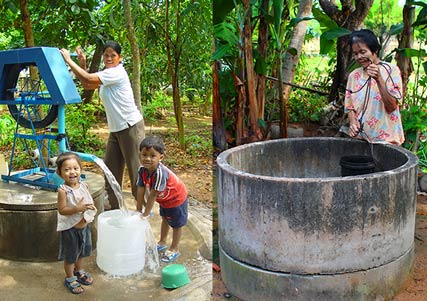Here you can see two inexpensive methods of harvesting and holding rain water. “Earth Tank” systems designed to serve individual families as well as regular tank systems designed to serve schools or entire villages are innovated and built by RDI. Rainwater harvesting is a cost effective way of using natural resources to provide safe, arsenic-free drinking water.
- No 50A, Phum Prek Thom Sangkat Kbal Koh, Khan Chbar Ampov
- 855 (0)12-200-235
- info@rdic.org

Rain Water Collection
Earth Tank System Overview
Earth Tank System Overview
For relatively small amount of money, RDI can build a 4,200 liter “Earth Tank” for a rural family. RDI developed this innovative structure and is inviting visiting teams to come out and build these tanks for needy families.
How does it work?
- Gutters are added to existing roofs of houses. (Where needed, a metal roof is offered.)
- A PVC pipe is run from the gutter to the sphere tank.
- During the rainy season, the tank fills up, giving a typical family of 6 enough water for an entire dry season.
- Water is collected out of the spigot.
- (The water can also be sent through the clay filter system at this step.)
- Drink up!
PROS: Inexpensive, very easy to clean (no corners means less breeding ground for bacteria). The enclosed design makes it hard for mosquito larvae and solids to contaminate the tank, light cannot get in which prevents algae growth and reduces food supply for dangerous pathogens, maximum structural strength with the least amount of materials, can be moved if necessary.
CONS: Compared to other rural mass water storage structures? None. However, no system of clean water delivery is complete without education coupled with the technology.
For further information about Earth Tank construction and implementation click here!
Ball Tank Overview

Rope Pump
New RDI innovations using locally obtainable parts have updated a previous design of this efficient water moving device. In essence, a rope with washers evenly spaced along its length reaches down into a well and captures water between the washers in a PVC pipe – pulling it up to the surface. Simply turning a hand crank delivers large volumes of water quickly and easily. A modified version of this pump is being developed to help retrieve river water during the dry season. By the end of the dry season, the level of the river can fall as much as 45 feet below normal leaving a steep, exposed river bed that is very difficult to negotiate, especially when trying to carry an ungainly water bucket. Pumping water with new version of the rope pump may involve something like pedaling a bicycle.
The technology associated with the rope pump is too important to be kept secret from thirsty people throughout the world. RDI is happy to share the information necessary to help make construction of these simple, yet very functional pumps possible for anyone anywhere.
Download Rope Pump Animation Quicktime
Download Rope Pump Animation WMV format
Rope Pump Compare to Traditional Open Well

Download Detail Rope Pump Drawings and Specifications

Full Color Rendering (no dimensions)

Pump Elevation (no dimensions)








